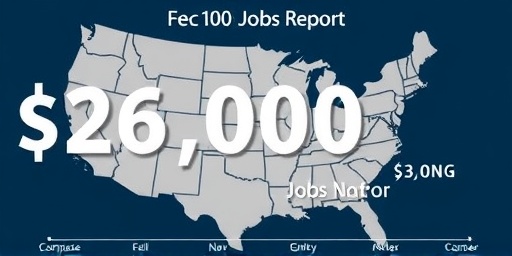The US economy demonstrated remarkable resilience in October, adding a robust 250,000 new jobs that far exceeded economists’ forecasts of around 180,000 positions. This strong performance in the latest Jobs report has eased concerns about a potential slowdown, with the unemployment rate holding steady at 4.1%. As the labor market continues to defy inflationary pressures and global uncertainties, investors and policymakers are taking note of this positive signal for the broader economy.
Key Metrics Reveal Labor Market’s Steady Climb
Delving into the details of the October Jobs report, released by the Bureau of Labor Statistics (BLS), reveals a multifaceted picture of growth. Nonfarm payrolls surged by 250,000, marking the third consecutive month of gains above 200,000. This figure not only beat the consensus estimate but also adjusted upward from September’s initial count of 336,000 jobs, now revised to 261,000 after accounting for Hurricane Helene’s disruptions in the Southeast.
Average hourly earnings rose by 0.2% month-over-month, translating to a 3.8% annual increase, which outpaces wage growth from the previous year. While this could fuel inflation worries, it also underscores workers’ bargaining power in a tight labor market. The labor force participation rate ticked up slightly to 62.8%, indicating more Americans are re-entering the workforce, potentially easing some supply-side constraints in the economy.
These numbers paint a picture of a labor market that is cooling gradually but not contracting. Compared to the peak hiring frenzy of 2023, when monthly additions often topped 300,000, October’s report suggests a normalization that’s healthy for sustainable growth. Economists had anticipated a dip due to seasonal factors and lingering effects from natural disasters, but the data shows the economy’s underlying strength.
Healthcare and Leisure Sectors Lead Job Creation Surge
Sector-specific breakdowns from the Jobs report highlight where the economy is thriving. The healthcare industry added 48,000 positions, continuing its streak as a reliable engine of job growth amid an aging population and post-pandemic recovery demands. Hospitals, nursing homes, and outpatient services saw broad-based hiring, with ambulatory health care services alone contributing 28,000 jobs.
Leisure and hospitality followed closely, gaining 54,000 jobs, driven by a rebound in travel and dining. Restaurants and bars accounted for much of this, as consumer spending on experiences remains resilient despite higher interest rates. This sector’s performance is particularly encouraging, as it had lagged during earlier recovery phases but now signals normalized demand in the service economy.
Professional and business services added 37,000 jobs, including gains in temporary help services and management consulting, reflecting businesses’ ongoing need for flexible staffing. Construction employment rose by 23,000, bolstered by infrastructure projects funded by recent federal legislation, while manufacturing held steady with minimal changes at just 1,000 new positions.
- Healthcare: +48,000 jobs, fueled by demand for medical professionals.
- Leisure and Hospitality: +54,000 jobs, highlighting tourism recovery.
- Professional Services: +37,000 jobs, indicating corporate expansion.
- Construction: +23,000 jobs, supported by public investments.
Notably absent were significant losses in retail or government sectors, which had faced headwinds in prior months. This diversified growth across industries underscores the labor market’s adaptability, even as the economy navigates high borrowing costs and geopolitical tensions.
Unemployment Rate’s Stability Masks Underlying Shifts
While the headline unemployment rate remained at 4.1%, a deeper look into the jobs report uncovers nuanced shifts in the labor market. The number of unemployed persons stayed flat at 6.8 million, but long-term unemployment—those out of work for 27 weeks or more—edged up slightly to 1.5 million, representing 22% of the total unemployed.
The underemployment rate, which includes part-time workers seeking full-time roles, held at 7.5%, a level that suggests slack is being absorbed slowly. Black unemployment rose marginally to 6.1%, while Hispanic unemployment dipped to 5.0%, showing varied experiences across demographics in this resilient economy.
Job openings data from the BLS’s separate JOLTS report, released concurrently, showed 8.1 million vacancies in September, down from 8.8 million in August. The quits rate, a gauge of worker confidence, fell to 2.2%, indicating employees are less eager to switch jobs amid economic uncertainty. These metrics collectively signal a labor market that’s balancing supply and demand without tipping into recession territory.
Experts note that the steady unemployment rate belies the jobs report’s positive momentum. “The labor market is proving more durable than anticipated,” said Mark Zandi, chief economist at Moody’s Analytics. “With unemployment not budging, it reinforces the narrative of a soft landing for the US economy.”
Economists and Policymakers React to Robust Data
The October jobs report has sparked a wave of optimistic commentary from economists and implications for monetary policy. Federal Reserve Chair Jerome Powell, in recent remarks, emphasized the need for data-dependent decisions, and this report tilts the scales toward a potential rate cut in December. Traders now price in an 85% chance of a 25-basis-point reduction, up from 70% before the release.
“This jobs report is a goldilocks scenario—not too hot, not too cold,” remarked Beth Ann Bovino, chief economist at U.S. Bank. She highlighted how the 250,000 job additions align with the Fed’s 2% inflation target path, reducing the urgency for aggressive hikes. Wage growth, while solid, is decelerating from its 5.5% peak in 2022, alleviating fears of a wage-price spiral.
On Wall Street, the data fueled a rally, with the S&P 500 climbing 1.2% on the release day. Tech stocks, sensitive to interest rate expectations, led gains, as lower borrowing costs could boost investment in AI and infrastructure. However, some caution persists: “While the labor market is strong, we must watch for cracks in consumer spending,” warned a report from Goldman Sachs analysts.
Politically, the report arrives ahead of the election cycle, bolstering narratives of economic recovery under the current administration. Labor Secretary Julie Su praised the figures, stating, “American workers are at the heart of this progress, and these jobs mean real opportunities for families across the nation.”
International perspectives also factor in. The European Central Bank, facing its own sluggish growth, views the US labor market’s performance as a benchmark for global resilience. Trade partners like Canada and Mexico, intertwined with US supply chains, may see spillover effects in their own job markets.
Future Outlook: Navigating Challenges Ahead for the Economy
Looking forward, the October jobs report sets a promising tone for the remainder of 2024, but challenges loom for the labor market and broader economy. November’s report, due in early December, will incorporate holiday hiring trends, potentially pushing additions toward 300,000 if retail and logistics ramp up as expected.
Inflation remains a wildcard; the Consumer Price Index for October showed core inflation at 3.3%, still above the Fed’s target. If wage pressures from the jobs report persist, it could delay rate cuts, prolonging higher borrowing costs for businesses and homebuyers. Geopolitical risks, including conflicts in the Middle East and Ukraine, add uncertainty to energy prices and supply chains, which could indirectly impact job growth.
Demographic trends offer long-term optimism. The BLS projects that healthcare and social assistance will add 2.2 million jobs by 2032, driven by retirements and an expanding elderly population. Renewable energy sectors, spurred by the Inflation Reduction Act, are poised for gains, with solar and wind installation jobs expected to grow 25% over the decade.
Policymakers face a delicate balance: supporting the labor market without overheating the economy. Upcoming GDP data and ISM manufacturing surveys will provide further context. If trends hold, the US could achieve a “soft landing,” where inflation cools without triggering widespread layoffs.
For workers, the report signals continued opportunities, particularly in high-demand fields like nursing and IT. Job seekers are advised to upskill in growing areas, while employers should prepare for talent competition. As the economy evolves, this jobs report serves as a reminder of its foundational role in driving prosperity and stability.
In summary, October’s impressive job gains and stable unemployment rate affirm the labor market’s pivotal strength, positioning the US economy for measured progress amid headwinds. Stakeholders from Wall Street to Main Street will watch closely as these dynamics unfold.









